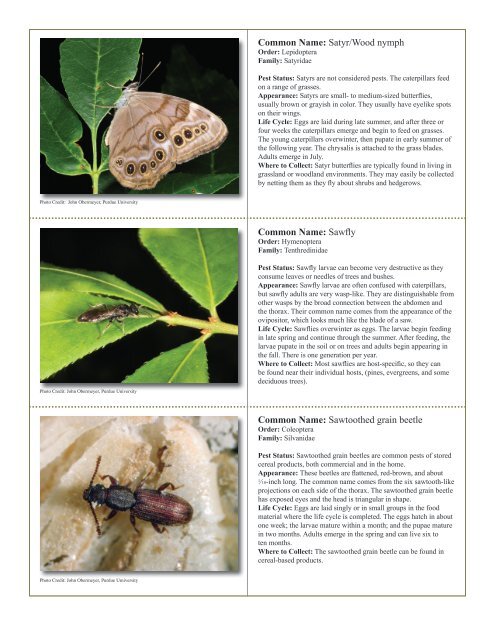to download pdf - Purdue Extension Entomology - Purdue University
to download pdf - Purdue Extension Entomology - Purdue University
to download pdf - Purdue Extension Entomology - Purdue University
Create successful ePaper yourself
Turn your PDF publications into a flip-book with our unique Google optimized e-Paper software.
Common Name: Satyr/Wood nymph<br />
Order: Lepidoptera<br />
Family: Satyridae<br />
Pest Status: Satyrs are not considered pests. The caterpillars feed<br />
on a range of grasses.<br />
Appearance: Satyrs are small- <strong>to</strong> medium-sized butterflies,<br />
usually brown or grayish in color. They usually have eyelike spots<br />
on their wings.<br />
Life Cycle: Eggs are laid during late summer, and after three or<br />
four weeks the caterpillars emerge and begin <strong>to</strong> feed on grasses.<br />
The young caterpillars overwinter, then pupate in early summer of<br />
the following year. The chrysalis is attached <strong>to</strong> the grass blades.<br />
Adults emerge in July.<br />
Where <strong>to</strong> Collect: Satyr butterflies are typically found in living in<br />
grassland or woodland environments. They may easily be collected<br />
by netting them as they fly about shrubs and hedgerows.<br />
Pho<strong>to</strong> Credit: John Obermeyer, <strong>Purdue</strong> <strong>University</strong><br />
Common Name: Sawfly<br />
Order: Hymenoptera<br />
Family: Tenthredinidae<br />
Pho<strong>to</strong> Credit: John Obermeyer, <strong>Purdue</strong> <strong>University</strong><br />
Pest Status: Sawfly larvae can become very destructive as they<br />
consume leaves or needles of trees and bushes.<br />
Appearance: Sawfly larvae are often confused with caterpillars,<br />
but sawfly adults are very wasp-like. They are distinguishable from<br />
other wasps by the broad connection between the abdomen and<br />
the thorax. Their common name comes from the appearance of the<br />
oviposi<strong>to</strong>r, which looks much like the blade of a saw.<br />
Life Cycle: Sawflies overwinter as eggs. The larvae begin feeding<br />
in late spring and continue through the summer. After feeding, the<br />
larvae pupate in the soil or on trees and adults begin appearing in<br />
the fall. There is one generation per year.<br />
Where <strong>to</strong> Collect: Most sawflies are host-specific, so they can<br />
be found near their individual hosts, (pines, evergreens, and some<br />
deciduous trees).<br />
Common Name: Saw<strong>to</strong>othed grain beetle<br />
Order: Coleoptera<br />
Family: Silvanidae<br />
Pest Status: Saw<strong>to</strong>othed grain beetles are common pests of s<strong>to</strong>red<br />
cereal products, both commercial and in the home.<br />
Appearance: These beetles are flattened, red-brown, and about<br />
1<br />
⁄10-inch long. The common name comes from the six saw<strong>to</strong>oth-like<br />
projections on each side of the thorax. The saw<strong>to</strong>othed grain beetle<br />
has exposed eyes and the head is triangular in shape.<br />
Life Cycle: Eggs are laid singly or in small groups in the food<br />
material where the life cycle is completed. The eggs hatch in about<br />
one week; the larvae mature within a month; and the pupae mature<br />
in two months. Adults emerge in the spring and can live six <strong>to</strong><br />
ten months.<br />
Where <strong>to</strong> Collect: The saw<strong>to</strong>othed grain beetle can be found in<br />
cereal-based products.<br />
Pho<strong>to</strong> Credit: John Obermeyer, <strong>Purdue</strong> Umiversity
















